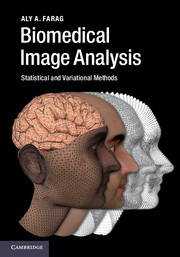Book contents
1 - Overview of biomedical image analysis
Published online by Cambridge University Press: 05 November 2014
Summary
Introduction
Image analysis is a vibrant field in research, applications, and technologies. Any image is a representation of data gathered by sensors from a physical environment. Biomedical image analysis deals with biological systems; this book focuses on analysis of images that describe the structure or function of the human body. Broadly speaking, biomedical image analysis includes three major components: segmentation, registration, and visualization. Each of these components is a science and art in its own right, with considerable literature spanning over four decades of theory, algorithms, and applications. Each component has been documented in books, conference proceedings, archived journals, technologies, and commercial products.
So a new book on this subject faces two questions: what can it add to the sea of progress, and what distinguishes it from similar books on the subject? The first of these is not a problem per se. This book addresses the common denominator in theory, algorithms and applications that has resulted from this sea of progress, tailored towards a particular audience. To answer the second question, the book covers what is not currently available in textbooks in terms of subjects and educational material. It aims to be a friendly welcome for newcomers to the field, treating it in a rigorous manner, yet without becoming overwhelmed by details. Specifically, the intended audience includes seniors and first-year graduate students in engineering, mathematics, and physics. Those who are experts in the field may also find the book appropriate as a refresher.
Information
- Type
- Chapter
- Information
- Biomedical Image AnalysisStatistical and Variational Methods, pp. 1 - 6Publisher: Cambridge University PressPrint publication year: 2014
